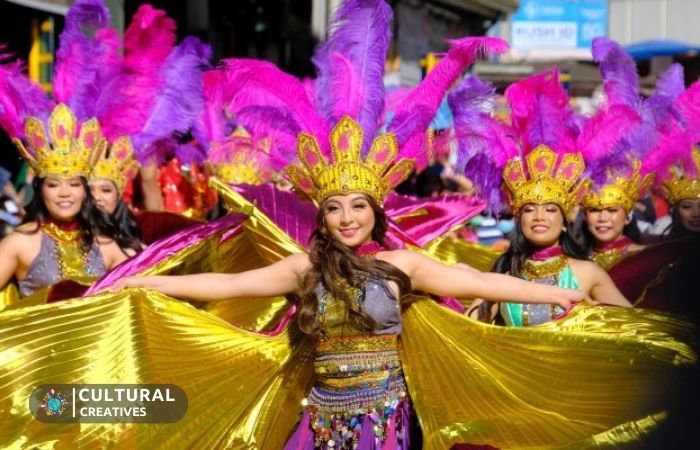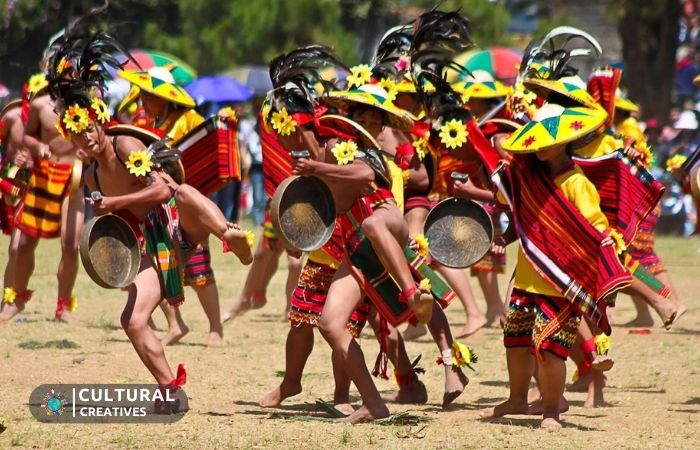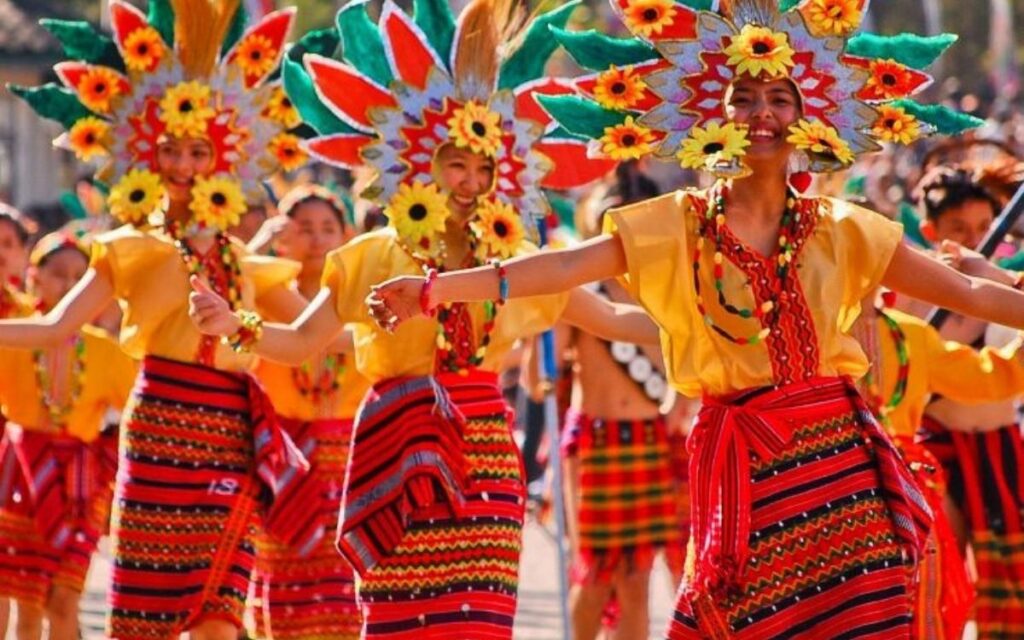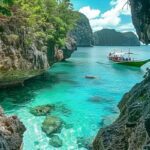The Panagbenga Festival is an annual flower festival celebrated in Baguio City, Philippines. It highlights the city’s rich culture and blooms through street dances and flower-decorated floats. The date of the celebrations is exactly held in February or beginning of the March.
Thousands gather in Baguio City to witness the Festival. It is an event with of rhythmic drum beats, and the exquisite scent of fresh flowers. The festival’s name derives from the local Kankanaey language, meaning “season of blooming,” fitting for a celebration that pays tribute to the city’s natural beauty and recovery after the 1990 earthquake.
Participants dressed in flower-inspired costumes dance through the streets, bringing the city’s roads to life with a dynamic blend of motion and music. The grand float parade showcases elaborate designs featuring a dazzling array of flowers, emphasizing the creativity and communal spirit of Baguio’s residents. The festival lasts for about a month, offering a variety of events that include garden shows, exhibits, and competitions, making it a true highlight for both tourists and locals seeking to immerse themselves in a rich cultural experience.
Panagbenga Festival History

Experience the bloom of culture and tradition at the Panagbenga Festival, a month-long annual flower festival that transforms the city of Baguio, Philippines, into a kaleidoscope of color and festivity. Known for its stunning floral floats, energetic street dances, and abundant local heritage, the festival is a true testament to the resilience and beauty of the Filipino spirit. If you’re a first-time visitor or a returning enthusiast, it offers a unique blend of natural splendor and cultural exhibition that captures the heart of everyone who witnesses it.
The Origin Of Panagbenga
The name Panagbenga comes from the Kankanaey term meaning “a season for blossoming, a time for flowering”. It represents not only the blooming of flowers but also signifies growth and the blossoming of Baguio’s community spirit. The festival began as a way to uplift the city’s spirits and economy after the devastating earthquake in 1990. A testament to the city’s resilience, it now stands as a symbol of Baguio’s ability to rise above adversity and has become one of the most iconic and famous festival in Philippines.
Annual Schedule And Duration
Typically kicking off in February and spanning the whole month leading into early March, it aligns with the time when flowers in the region start to bloom. The celebration lasts around five weeks and includes a variety of events such as the Grand Street Dancing Parade, Grand Float Parade, Session Road in Bloom, and more. Each activity showcases the city’s rich culture, creativity, and love for flowers, drawing thousands of visitors both locally and internationally.
Key events take place on weekends, ensuring vibrancy throughout the entire month. The festival schedule is carefully crafted to include highlights such as:
- Grand Opening Parade: A showcase of the festival’s spirit with dance, music, and performances.
- Market Encounter: Where local vendors display their crafts and flower arrangements.
- Grand Street Dancing Parade: A colorful display of local dance troupes competing in traditional and modern dance interpretations.
- Grand Float Parade: The festival’s centerpiece event featuring floats decorated with flowers.
- Session Road in Bloom: The main thoroughfare turns into a lively pedestrian street filled with food stalls, exhibits, and entertainment.
The Cultural Significance Of The Festival

Every year, the festival sanctifies the identity of Baguio City, bringing forth a vivid symphony of color, tradition, and growth. This illustrious event is more than a mere celebration; it’s an emblematic representation of the city’s history, its natural beauty, and the undying spirit of its community. Below, we delve into the different aspects of the festival that contribute to its rich cultural tapestry.
Tribute To Baguio City’s Flourishing Flowers
This tribute to nature’s bounty is depicted in the dazzling floats adorned with flowers that parade down Session Road, exuding an aura of renewal and resilience after the city’s recovery from the earthquake of 1990. The festivities, including garden competitions and floral exhibitions, underscore the city’s deep-rooted connection with nature and the importance of preserving its natural heritage.
Influence Of Filipino Traditions And History
At its core, Panagbenga is a profound narrative of Filipino customs and historical moments. The festival’s events such as the Grand Street Parade and Grand Float Parade echo traditional Filipino fiestas. The influence of the country’s history is reflected in the dance and music integral to the celebration, which pay homage to the indigenous people and the significant cultural intersections shaped by Spanish and American colonial eras.
Impact On Community And Economic Development
The festival is not only a feast for the senses but also a vital driver for community and economic progress. Local artisans, performers, and entrepreneurs take the spotlight, showcasing the city’s creative spirit. Additionally, the festival stimulates tourism, leading to significant financial inflows that benefit local businesses and infrastructure. It’s a testament to the cohesive power of culture, bringing together residents and visitors alike in celebration, supporting livelihoods, and fostering long-term prosperity.
Main Events And Attractions

This festival is referred to as the Flower Festival, is a month-long annual celebration occurring in Baguio City, Philippines. Rooted in the traditions and culture of the Cordilleras, the festival boasts a multitude of vibrant and energizing events that draw tourists and enthusiasts from all corners of the globe. Let’s delve into the effervescent main events and attractions that are the heart and soul of Panagbenga.
Grand Street Dancing Parade: A Colorful Showcase
The Grand Street Dancing Parade is a feast for the senses with its dynamic mix of pageantry and cultural display. Participants, dressed in eye-catching costumes, dance to the upbeat rhythms of Cordillera’s folk music, showcasing a rich tapestry of traditional and contemporary dance moves. The procession turns the city into a kaleidoscope of colors, with every step and beat telling tales of the region’s history and heritage.
Float Parade: Artistry And Creativity In Bloom
Creativity takes center stage at the Float Parade, where ingeniously designed floats, laden with innumerable flowers, parade down the streets of Baguio. Each float is an elaborate structure of fresh blooms, highlighting artistic concepts that range from the reflective to the whimsical. This event is not only a spectacle of beauty but also a competition that brings out the best in floral artistry and inventive expression.
Exhibition And Landscaping Contests: Celebrating Green Thumbs
The Exhibition and Landscaping Contests are a green-thumbed enthusiast’s dream. Roving through beautifully curated gardens, visitors can witness the horticultural prowess of the contestants. The competitive spirit thrives here as landscapers and garden designers transform spaces into enchanting havens, using an assortment of plants, flowers, and sometimes, unconventional materials to create their green masterpieces.
Other Festival Activities: Markets, Concerts, And Fireworks
- Markets: The festival’s markets are a treasure trove for those seeking to take home a piece of Panagbenga. Stalls overflow with goods from fresh blooms and local handicrafts to delightful street food. The local vibe is tangible, as artisanal wares and souvenirs beckon festival-goers.
- Concerts: As night falls, the energy does not wane. Baguio City’s parks and outdoor stages come alive with the sound of music. Concerts featuring local bands, as well as renowned Filipino artists, provide an auditory treat synonymous with merriment and good spirits.
- Fireworks: The festival is capped off with a grand fireworks display, painting the night sky with an orchestra of light. This spectacular show marks the culmination of the Panagbenga Festival, leaving a resounding impression of joy and celebration in the hearts of all who witness it.
Experiencing Panagbenga As A Visitor

The festival is celebrated annually in the City of Pines – Baguio City, Philippines. As a visitor, the parade of flower floats, traditional dances, and the aroma of local dishes provide a sensory feast unlike any other. To get the most out of this unforgettable celebration, here are some insider tips for navigating the festivities.
Best Practices For Travel And Accommodation
With the festival drawing in thousands, securing travel and accommodation well in advance ensures a stress-free experience:
- Book Early: Hotels fill up quickly. Aim to reserve your stay at least a few months ahead.
- Stay Central: Look for accommodation near Session Road to be close to the action and lessen the need for transportation.
- Travel Smarts: Check flights that go directly to Baguio or opt for a scenic bus ride if coming from Manila.
Navigating The Crowds: Tips And Safety
| Tips | Safety |
|---|---|
| Review the parade route and set a meeting point in case you get separated from your group. | Keep personal belongings secure and stay vigilant, as pickpockets are common in crowded events. |
| Arrive early to secure a good viewing spot, but also be prepared to stand for several hours. | Always follow the instructions of the event security and staff for a safe experience. |
Interactive Cultural Experiences
Engage with local traditions by participating in interactive cultural experiences:
- Join in the flower-arranging workshops conducted by local artisans.
- Take part in the traditional dances often showcased at cultural venues around the city.
- Visit local galleries and museums to embrace the artistic heritage of the region.
Taste Of The Festival: Local Cuisine And Delicacies
Don’t miss the chance to savor Baguio’s gastronomic delights:
- Strawberry Taho: A unique twist to a Filipino street food staple made with fresh local strawberries.
- Pinikpikan: A traditional Cordilleran chicken dish that’s a must-try for meat lovers.
- Panagbenga Salad: This edible flower salad captures the essence of the festival on a plate.
Delight in these and other culinary offerings at food stalls lining the streets, infusing your Panagbenga experience with the flavors of the region.
Preserving Tradition While Embracing Change

A month-long celebration in Baguio City, Philippines, stands as a testament to the Filipino spirit of resilience and innovation. Initially intended to honor the city’s flowers and to rejuvenate tourism after an earthquake, the festival has since evolved into a colorful tapestry that reflects both the preservation of tradition and the move towards modernity. Let’s delve into how the Panagbenga Festival maintains its cultural roots while smoothly incorporating contemporary shifts.
The Role Of Modernization In The Festival’s Evolution
The interplay between tradition and modernity at the Panagbenga Festival is evident through its transformative journey. From a simple flower festival, it has blossomed into an event that captivates the digital age. Social media now amplifies the festival’s reach, with stunning images and live streams making the experience accessible worldwide. Incorporating modern technology not only preserves the core festivities but also ensures that they thrive in the consciousness of a global audience.
Moreover, the festival organizers consistently introduce fresh elements like drone displays and digital art installations, ensuring the relevance of Panagbenga to younger generations. These technological advancements provide a new perspective while celebrating the enduring charm of local traditions.
Conservation Efforts For Sustainability
The increasing popularity of the Panagbenga Festival brings a responsibility to balance festivity with sustainability. Environmental conservation plays a critical role in maintaining the natural beauty that the festival honors. Measures such as using biodegradable materials in floats and encouraging eco-friendly practices among participants are fundamental.
- Waste management campaigns during the event
- Limiting single-use plastics within the festival’s vicinity
- Community clean-up drives post-celebration
These initiatives reflect a commitment to ecological conservation, ensuring the festival leaves a green footprint and retains the very essence of appreciating nature’s abundance.
Festival’s Response To Globally Relevant Themes
Each year, the Panagbenga Festival adopts themes that resonate with global conversations. This responsiveness to current affairs and worldwide trends ensures the festival remains pertinent and insightful. Themes such as climate change awareness, cultural solidarity, and global peace have taken center stage, using the festival as a platform to educate and unite.
The incorporation of these themes is done thoughtfully, often through the artistic expression of floats, street dancing, and costuming. This approach not only highlights critical issues but also invites active participation from the audience in these larger dialogues.
Conclusion
As the Panagbenga Festival draws to a close, the vibrancy of Baguio City’s celebration remains unforgettable. The streets, alive with color and tradition, reflect a rich cultural tapestry. This annual bloom of festivity not only honors the beauty of flowers but also fosters community spirit.
If you’ve attended in person or enjoyed it virtually, the festival’s spectacle is one to cherish. Embrace the memories made, and anticipate next year’s floral fanfare.






